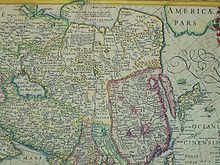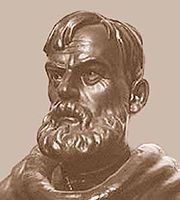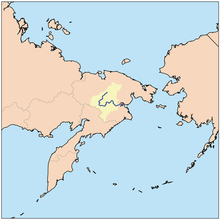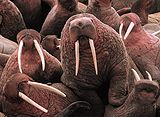- Semyon Dezhnyov
-
Semyon Ivanovich Dezhnyov (Russian: Семён Ива́нович Дежнёв, IPA: [sʲɪˈmʲɵn ɪˈvanəvʲɪt͡ɕ dʲɪˈʐnʲɵf]; commonly spelled Dezhnev in English-language sources; c. 1605 – 1672) was a Russian explorer of Siberia and the first European to sail through the Bering Strait. In 1648 he sailed from the Kolyma River on the Arctic Ocean to the Anadyr River on the Pacific. His exploit was forgotten for almost a hundred years and Vitus Bering is usually given credit for discovering the strait that bears his name.
 The expedition of Semyon Dezhnyov by Klavdy Lebedev
The expedition of Semyon Dezhnyov by Klavdy Lebedev
Contents
Biography
He was Pomor, born about 1605, possibly at Veliky Ustyug or the village of Pinega. According to Lydia Black (2004: 17), Dezhnyov was recruited for Siberian service, possibly as a service-man or government agent, in 1630. He served for eight years in Tobolsk and Yeniseisk, and then went to Yakutia in 1639, or possibly earlier. He ”is said to have been a member of the Cossack detachment under Beketov, who is credited with founding Yakutsk (on the Lena River) in 1632. In any case, no later than 1639 he was sent to Yakutia, where he married a Yakut captive and spent the next three years collecting tribute from the natives. [1]
In 1641 Dezhnyov moved northeast to a newly-discovered tributary of the Indigirka River where he served under Mikhail Stadukhin. Finding few furs and hostile natives and hearing of a rich river to the east, he and Stadukhin and Dmitry Zyrian sailed down the Indigirka, then east along the coast and until the Kolyma River and built an ostrog (1643). This was the time the easternmost Russian frontier.[1] The Kolyma soon proved to be one of the richest areas in eastern Siberia. In 1647 396 men paid head-tax there and 404 men received passports to travel from Yakutsk to the Kolyma.
From about 1642, Russians began hearing of a ‘Pogycha River’ to the east which flowed into the Arctic and was rich in sable fur, walrus ivory and silver ore. An attempt to reach it in 1646 failed. In 1647 Fedot Alekseyev, an agent of a Moscow merchant, organized an expedition and brought in Dezhnyov because he was a government official. The expedition reached the sea but were unable to round the Chukchi Peninsula[1] because they had to turn back due to thick drift ice.
The following year (1648), they tried again. Fedot Alekseyev was joined by two others, Andreev and Afstaf’iev, representing the Guselnikov merchant house, with their own vessels and men, while Alekseyev provided five vessels and the majority of the men. Also Gerasim Ankudinov, with his own vessel and 30 men, joined the expedition. Dezhnyov recruited his own men, 18 or 19, for fur gathering for private profit, as was the custom at the time. The whole group numbered between 89 and 121 men, travelling in traditional koch vessels. At least one woman, Alekseyev’s Yakut wife, was with this group.[2]
On 20 June 1648 (old style, 30 June new style) they departed from (most likely) Srednekolymsk and sailed down the river to the Arctic. Next year it was learned from captives that two koches had been wrecked and their survivors were killed by the natives. Two other koches were lost in a way that is not recorded. Some time before 20 September (o.s) they rounded a ‘great rocky projection’. Here Ankudinov’s koch was wrecked and the survivors were transferred to the remaining two. At the beginning of October a storm blew up and Fedot’s koch disappeared. (In 1653/4, Dezhnyov captured from the Koryaks Fedot’s Yakut woman who had accompanied him from the Kolyma. She said that Fedot died of scurvy, several of his companions were killed by the Koryaks and the rest fled in small boats to an unknown fate). Dezhnyov’s koch was driven by the storm and was eventually wrecked somewhere south of the Anadyr. The remaining 25 men wandered in unknown country for 10 weeks until they came to the mouth of the Anadyr. Twelve men went up the Anadyr, walked for 20 days, found nothing and turned back. Three of the stronger men got back to Dezhnyov and the rest were never heard of again. In the spring or early summer of 1649 the remaining 12 men built boats from driftwood and went up the Anadyr. They were probably trying to get out of the tundra into forested country for sables and firewood. About 320 miles upriver they built a zimov’ye (winter quarters) somewhere near Anadyrsk and subjected the local Anauls to tribute. Here they were effectively stranded.
In 1649 Russians on the Kolyma ascended the Anyuy River branch of the Kolyma and learned that one could travel from its headwaters to the headwaters of the Pogycha-Anadyr. In 1650 Stadukhin and Semyon Motora followed this route and stumbled onto Dezhnyov’s camp. The land route was clearly superior and Dezhnyov’s sea route was never used again. Dezhnyov spent the next several years exploring and collecting tribute from the natives. More cossacks arrived from the Kolyma, Motora was killed and Stadukhin went south to find the Penzhina River. Dezhnyov found a walrus rookery at the mouth of the Anadyr and ultimately accumulated over 2 tons of Walrus ivory which was far more valuable than the few furs found at Anadyrsk.
In 1659 Dezhnyov transferred his authority to Kurbat Ivanov, the discoverer of Lake Baikal. In 1662 he was at Yakutsk. In 1664 he reached Moscow in charge of a load of tribute. He later served on the Olenyok River and the Vilyuy River. In 1670 he escorted 47,164 rubles (a soldier was paid about 5 rubles a year) of tribute to Moscow and died there in late 1672.
Dezhnyov’s 1648 expedition results summarized
As stated above, Dezhnyov traveled with Fedot Alekseyev two others, Andreev and Afstaf’iev. Except for Dezhnyov, none of the other leaders of this expedition survived to tell their tale. Dezhnyov rounded the eastern extremity of Asia, East Cape, now known to Russians as mys Dezhenyova (‘Cape Dezhnyov’), possibly[3] made landfall on the Diomede Islands, sailed through Bering Strait, reached the Anadyr River, ascended it and founded the Anadyr ostrog.[2] Four out of the seven vessels were lost before even reaching Bering Strait, and Ankudinov’s koch was wrecked in or near Bering Strait. This meant that only two vessels went beyond the strait. Alekseyev’s boat is believed by some[4] to had made landfall in the vicinity of the Kamchatka River, further down the coast of Kamchatka. It appears that scholars agree only on the fate of Dezhnyov’s vessel, which was not lost. It was widely believed at the time that these vessels had reached the American shore and that their men had founded a Russian settlement there.[2] Such a colony was searched for by many Russian expeditions launched by the Russian-American Company from 1818 on and during the early 1820’s.[5][6]
A Discovery and its Re-Discovery
 A 1610 map by Jodocus Hondius showing the Strait of Anian (Anian Fretum) at the approximate location of the Bering Strait
A 1610 map by Jodocus Hondius showing the Strait of Anian (Anian Fretum) at the approximate location of the Bering Strait
From at least 1575 European geographers had heard of a Strait of Anian connecting the Pacific and Atlantic. Some had it at the Bering Strait (map at right) and others had it running from the Gulf of California to Baffin Bay.[7][8] It is not certain that Russians in Siberia had heard of it. The first Western map to show a Strait of Anian between Asia and North America was probably that of Giacomo Gastaldi in 1562. Many cartographers followed this until the time of Bering. The source is said to be an interpretation of Marco Polo, but otherwise the documents do not explain where the idea came from.
Dezhnyov was illiterate or semi-literate and probably did not understand the importance of what he had done. He certainly did not sail across to Alaska, prove that there was no land bridge to the north or south or compare his knowledge to that of learned geographers. Nowhere did he claim to have discovered the eastern tip of Asia, merely that he had rounded a great rocky projection on his way to the Anadyr.
Dezhnyov left reports at Yakutsk and Moscow but these were ignored, probably because his sea route was of no practical use. For the next 75 years garbled versions of the Dezhnyov story circulated in Siberia. Early Siberian maps are quite distorted but most seem to show a connection between the Arctic and Pacific. A few have hints of Dezhnyov. Dutch travelers heard of an ‘Ice Cape’ at the east end of Asia. Bering heard a story that some Russians had sailed from the Lena to Kamchatka. In 1728 Vitus Bering entered Bering Strait and, by reporting this to Europe, gained credit for the discovery. In 1736 Gerhardt Friedrich Müller found Dezhnyov’s reports in the Yakutsk archives and parts of the story began filtering back to Europe. In 1758 he published ‘Nachricten von Seereisen ....’, which made the Dezhnyov story generally known. In 1890 Oglobin found a few more documents in the archives. In the 1950s some of the originals that Muller copied were rediscovered in the Yakutsk archives.
Doubts on real Dezhnyov's route
From at least 1777 various people have doubted the Dezhnyov story. The reasons are: 1) the poor documentation, 2) the fact that no one was able to repeat Dezhnyov’s route until Adolf Erik Nordenskiöld in 1878/79 (Eight unsuccessful attempts were made between 1649 and 1787. There is some evidence that 1648 was unusually ice-free), 3) and most important, the fact that the documents can be read to imply only that Dezhnyov rounded a cape on the Arctic coast, was wrecked on that coast and wandered for 10 weeks south to the Anadyr. However, most scholars seem to agree that the Dezhnyov story as we have it is basically correct.
Cape Dezhnyov
In 1898 the east cape of Asia was officially renamed Cape Dezhnyov, and a large monument was erected in the explorer’s memory on the seacoast, complete with stone bust and iron star. Both the Soviet Union and Russia have named icebreakers after Dezhnyov.[9][10]
References
- Raymond H Fisher: The Voyage of Semen Dezhnev in 1648, The Hakluyt Society, 1981.
- Lydia Black: Russians in Alaska, 1732–1867, p. 17. University of Alaska Press, Fairbanks, Alaska, 2004.
- Ogloblin, N. N.: Semeon Dezhnyov, SPb, 1890.
- ^ a b c Lydia Black (2004: 17).
- ^ a b c Lydia Black (2004: 18).
- ^ The original documents describe the inhabitants of two islands near the great rocky projection, but it is not clear that these were the Diomedes
- ^ This sounds like a misunderstanding of the Fedotov story. Fisher's interpretation is given in Fedot Alekseyev Popov
- ^ Fedorova, Svetlana Grigor’evna: Русское население Аляски и Калифорнии: Конец XVIII века–1867 г. , p. 46–96. Наука, Москва, 1971; The Russian Population in Alaska and California, Late 18th Century — 1867. Materials for the Study of Alaska History, No. 4, p. 39–99. The Limestone Press, Kingston, Ontario, 1973.
- ^ Tihmenev, P. A.: A History of the Russian American Company, p. 158. Transl. Richard A. Pierce & Alton S. Donnelly. University of Washington Press, Seattle, 1978.
- ^ Samuel Elliot Morrison, The European Discovery of America, 1971
- ^ Derek Hayes,’Historical Atlas of the North Pacific Ocean’,2001
- ^ Philbin III, Tobias R., The Lure of Neptune: German-Soviet Naval Collaboration and Ambitions, 1919 - 1941, University of South Carolina Press, 1994, ISBN 0-87249-992-8, page 138-9
- ^ "Restrictions to Navigation". Archived from the original on 2010-02-18. http://www.webcitation.org/query?url=http%3A%2F%2Fwww.bsis.eisdienst.de%2Fmaterial%2FIcebreakerservice.pdf&date=2010-02-18.
Categories:- 1600s births
- 1673 deaths
- Russian explorers
- 17th-century explorers
- Explorers of Siberia
- Russian and Soviet polar explorers
- Bering Sea
- Chukchi Sea
- East Siberian Sea
- Pomors
Wikimedia Foundation. 2010.




